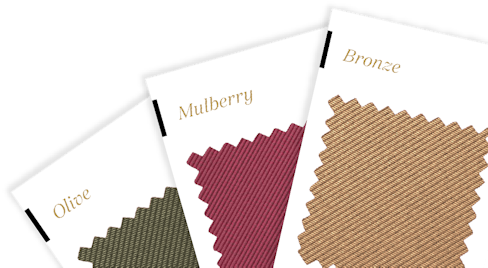What Is the Difference Between a Tuxedo and a Suit?

While you might hear the words suit and tux used interchangeably, there are distinct differences between a tuxedo and a suit, along with specific occasions for each formalwear option. Suits and tuxedos differ in their physical style, features, material, and overall look. Knowing the difference between these two elegant men's fashion staples is essential if you're attending a formal event.
Here, we'll review the difference between a tuxedo and a suit and when to wear them.
Setting the Stage: The Tuxedo and Suit Showdown
Perhaps you're a groomsman at your friend's wedding. You're looking forward to the event but unsure what to wear. Knowing the difference between tuxedos and suits is crucial for such situations. Tuxedos are usually considered more formal for black tie and evening events. On the other hand, suits offer more variation and are appropriate for several occasions, even substituting tuxes if you style them appropriately.
However, the rules of suit-wearing are much less strict now. Contemporary fashion allows more people to blur the lines and showcase their personal style in formal clothing.
Distinguishing Styles: Tuxedos vs. Suits
Before covering the occasions when either style is appropriate, we'll first need to look closely at the physical differences between suits and tuxedos. This includes differences in the buttons, lapels, and material, as well as the overall style.
The most notable difference is the use of satin or lack thereof. Tuxedos have satin detailing on the lapels, buttons, pocket trim, and usually a strip down the pants. However, suits don't have material detailing, and their buttons are either plastic or the same material as the coat.
Tuxedo jackets will also feature besom (piped) pockets cut into the fabric of the jacket with additional satin trimming along the slit. Most suit jackets have flap pockets instead.
You'll also have to consider the differences in accessories. Traditionally, tuxedos are only worn with black bow ties, a white shirt with a turn-down collar, wing, and French cuffs. However, this standard only applies to the traditional distinctions associated with black tie events. Nowadays, it's commonly acceptable to wear a tuxedo with a regular tie and other dress shirts if paired correctly.
With a rich history, dating back to the 19th century, tuxedos have become synonymous with elegance, sophistication, and the formality of black-tie events. It's a cornerstone of men's formalwear. A suit, however, is more associated with versatility and work professionalism. You can customize a suit to create a unique style that is classy and appropriate for formal events too.
The Classy Showdown: Dinner Suit vs. Tuxedo
You might be surprised to discover that tuxedos and dinner suits might mean the same thing. Yep, the names only differ in their regional dialects. In the U.S., tuxedo or "tux" is the appropriate terminology. Brits, however, will frequently call the same outfit a dinner suit.
Specifically, the difference lies in the terms "dinner jacket" and "tuxedo."
Simon Cundey, managing director of Henry Poole & Co and one of London's oldest tailors on Savile Row, noted how Henry Poole created the first tuxedo jacket for none other than Edward VII. The king specifically asked for a more relaxed evening fit, and Henry Pool responded by designing a coat without tails. Thus, the UK's dinner jacket was born.
James Potter, another customer of Poole's, mimicked the style and took it back to "Tuxedo Park" in New York. As more people in Tuxedo Park adopted the style, the name "Tuxedo" eventually caught on. The tuxedo became ideal for black tie events, Gala dinners, formal balls, formal weddings, opera, ballets, and award ceremonies.
Over time, dinner jackets started to depart from the usual black or midnight blue colors. The modern dinner jacket is worn alongside tuxedo pants and has satin detailing just like a tuxedo jacket. However, the jacket will usually have contrasting colors such as purple or white, despite the pants still being black or midnight blue. The look is a great option if you want to stand out, but needs to be styled carefully as it might clash with the event's aesthetic.
As a result, a "dinner suit" might be the same thing as a tuxedo depending on who you ask, but in some cases, it will be a colored dinner jacket with black or dark blue pants.
Layered Elegance: Three-Piece Suit vs. Tuxedo
For those who desire a higher formality than a regular suit but aren't set on a tuxedo, the option of three-piece suits also exists. This suit variation includes pants, a jacket, and a waistcoat, all made from the same fabric.
Tuxedos are still more formal, but three-piece suits bridge the gap between a two-piece suit's versatility and elevate it. The waistcoat is an opportunity to add a pop of color or pattern for less formal events. Even when taking off the jacket, you still appear fully dressed. Three-piece suits also work well in lower temperatures as they offer an added layer of warmth. Being highly customizable, you'll commonly see three-piece suits in business settings, weddings, and semi-formal occasions.
Regarding waistcoat style, you should use conservative options such as navy or black for more formal events. However, with contemporary fashion, many will use a different color waistcoat with their suit jackets. This look can be challenging to pull off but works well in navy and charcoal suit combinations.
Formal vs. Semi-Formal: Business Suit vs. Tuxedo
Many might also want to know the differences between tuxedos and business suits. While primarily for office and corporate spaces, business suits can also be appropriate for a range of semi-formal events. With matching trousers and a jacket, standard colors will include navy, black, and charcoal. Business suits also use long ties rather than bow ties, commonly seen on tuxedos. However, tie colors will frequently be subdued to match business settings and jacket colors.
For personal style and less formality, you can lose the tie or consider other suit colors, such as champagne, light gray, and burgundy. This makes it a customizable choice that is potentially good for a degree of formality in weddings, religious services, and graduations.
Cutting a Figure: Fit Differences in Tuxedos and Suits
Next to physical characteristics, tuxedos, and suits are generally different in how they fit. This adds to the overall contrast in style. While both are elegant, these significant differences in tailoring influence the formality.
Jacket Junction: Tuxedo Jacket vs. Suit Jacket
The jacket is the first fit difference between tuxedos and suits. Typically, tuxedos have minimal shoulder padding. The taper will outline your shoulder line with a closer, structured fit, adding to a polished and elegant appearance. Tuxedos also have besom pockets covered with a thin strip of satin while sporting shawl or peak style lapels.
Although well-fitted, suits have a more relaxed look and fit than tuxedos. They tend to have more room in the shoulders and waist for comfortable everyday wear. However, this will also differ depending on personal style. Italian-style suits tend to fit more snugly, while an American-style suit will seem more open.
Suits usually come with flap pockets or patch pockets with a cover made from the same material as the jacket. Peak lapels are prevalent with double breasted suits while notch lapels are more common with single-breasted suit jackets.
Tailored Trendsetters: Tuxedo Pants vs. Suit Pants
Tuxedo and suit pants also vary due to their respective styles. You'll never find belt loops on tuxedos. Instead, you use suspenders hidden under the jacket or side tabs. This makes the style look more uniform, sleek, and elegant.
When it comes to suits, belts are the way to go, and there's no shortage of options there. For a coordinated look, they should match your shoes or tie.
Feeling the Fabric: Material Differences in Tuxedos and Suits
Besides formality, tuxedos, and suits also differ in fabric. Tuxedos are made from various materials, but always have satin detailing on the lapels, buttons, pants, and pocket trim.
Suits can also be made from various materials, but their exteriors are uniform, with lapels and pockets sharing the material of the jacket.
Weaving a Tale: Tuxedo vs. Suit Material
Apart from nearly mandatory satin embellishments, tuxedos are frequently made from several fabrics, including wool, cotton, rayon, or polyester blends, giving them a characteristic shine. Tuxedos will also have stiffeners made from felt below the collar to streamline the look. The specific combination of materials gives tuxedos their signature luxurious sheen and smooth style.
Suits are much more versatile; you can typically find various seasonal materials. Some common suit materials include wool, cotton, linen, and particular blends. The suit will feel differently depending on the material. Wool blends are typically a bit stiffer, but cotton or linen blends make it more flowy. High-end suits can also have metal or bone buttons.
Event Etiquette: Tuxedos and Suits for Different Occasions
Ultimately, your choice between a tuxedo and a suit will be influenced by the occasion, dress code, and etiquette. The physical features of both styles are meant to reflect the level of formality. Modern fashion allows for more variation, so the distinctions aren't as clear-cut.
In general, tuxedos are best for:
- Black tie events and formal occasions
- Members of the wedding party (groom and groomsmen)
- Formal galas or balls
- High-profile award ceremonies
- Ballet or opera premieres
On the other hand, suits can be worn for the following events:
- Business meetings and conferences
- Weddings attendants
- Funerals
- Graduations
- Dinner parties
- Religious ceremonies
- Less formal dinner parties
- Court appearances
The Wedding Wardrobe: Black Suit vs. Tuxedo
For many, choosing between a black suit and a tuxedo for a wedding might be challenging. Both offer a certain level of elegance. So how do you choose the right one? While the two might look similar, there are some crucial nuances. Your choice will largely depend on the formality of the wedding and time.
Firstly, if you're a groomsman, you should ask the groom for the dress code. If it's a black-tie event, you might be expected to wear the tuxedo and match with other groomsmen. Tuxedos are also the proper choice if the wedding is in the evening. On the other hand, if not explicitly a black-tie event, you can choose a black suit with a regular tie as a balance of formality and personal style.
Time and Place: Deciding When to Wear a Tuxedo vs. Suit
Weddings aren't the only place where you'll be expected to choose from a tuxedo or a suit. Generally, you should save the tuxedo for only black tie and evening events.
The dress code tends to be more relaxed for outdoor settings such as a beach or a garden party. In such events, wearing a dark or even lighter suit is appropriate.
To be sure, consider asking the host to clarify the dress code. This will ensure you'll follow the appropriate conventions and look your best.
Bringing It Together: Unraveling the Tuxedo and Suit Debate
Overall, the most apparent difference between suits and tuxedos is the use of satin. Tuxedo lapels, buttons, and pant strips typically have satin, while suits do not. Formality is yet another consideration. Suits tend to be more versatile and are adequate for semi-formal events. At the same time, tuxedos are expected for black tie and evening events.
The two are also different in terms of accessories. Tuxedos usually need a black bow tie to complete the look, while suits use long ties. Likewise, tuxedos don't have belt loops but side tabs that cinch the waist. This complements the clean and formal aesthetic.

Roshana Pourvakil
Roshana Pourvakil has been with Generation Tux since 2022, combining expertise in weddings, formalwear, and fashion with a passion for impactful marketing. She values the transformative power of suits and tuxedos, blending timeless sophistication with modern style. Her work includes leading campaigns and creating narratives that inspire unforgettable wedding moments.
Link to bio pageFeatured Products
Get started.
Stylish suits and tuxedos delivered straight to your door. See our collection and rent now.

